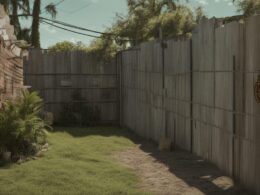Welcome to our comprehensive guide on preventing and treating fungal infections in your St. Augustine grass. Fungi can wreak havoc on your lawn, causing unsightly patches of brown grass and hampering its overall health and beauty. In this article, we will provide you with valuable lawn care tips to safeguard your St. Augustine grass from fungal invasions and help you maintain a lush and vibrant lawn.
Keeping your lawn free from fungal infections requires knowledge and proactive measures. By implementing the right practices, you can prevent these diseases from taking hold and ensure the longevity of your St. Augustine grass. From identifying common fungal infections to understanding their causes and implementing effective treatments, we’ve got you covered.
But first, let’s explore the different types of fungi that commonly infect St. Augustine grass:
- Powdery mildew
- Snow mold
- Necrotic ring spot
- Fairy ring disease
- Red thread disease
- Brown patch fungus
- Take All Root Rot
Each of these fungal infections presents unique challenges, but with the right techniques and preventive measures, you can maintain a healthy lawn. In the following sections, we will delve into each fungus, providing identification tips and discussing effective prevention and treatment strategies.
Remember that prevention is key when it comes to fungal infections. By implementing our tried-and-tested lawn care tips, you can ensure the vitality of your St. Augustine grass and enjoy a lush and vibrant lawn year-round. So let’s get started and arm ourselves with the knowledge to battle St. Augustine fungus!
Common Fungal Infections and How to Prevent Them
Fungal infections like powdery mildew, snow mold, and necrotic ring spot can wreak havoc on your St. Augustine grass. These infections can cause discoloration, patchiness, and overall decline in the health of your lawn. To ensure the wellbeing of your turf, it is essential to implement preventive measures to keep these fungi at bay.
Powdery mildew prevention: Choose grass varieties that are resistant to powdery mildew. These varieties have natural defenses that can help combat the fungus. Additionally, ensure proper sunlight exposure by trimming overhanging branches or thinning nearby shrubs. This will create an environment that is less favorable for powdery mildew to thrive.
Snow mold prevention: Snow mold typically occurs in late winter or early spring, when a layer of snow covers the grass for an extended period. To prevent snow mold, make sure to remove excess thatch and keep the grass clear of leaves and debris before the first snowfall. Adequate airflow is key to preventing snow mold, so avoid piling snow on top of your lawn.
Necrotic ring spot prevention: Necrotic ring spot is a fungal disease that occurs in hot and humid weather conditions. To prevent this infection, promote proper drainage by aerating your lawn regularly. This will improve water penetration and reduce the chances of fungal growth. Adjusting your irrigation schedule to water deeply but infrequently can also help prevent necrotic ring spot.
Regularly applying preventive fungicides can be an effective measure to keep these fungal infections in check. Consult with a lawn care professional or refer to the product’s label for proper application and dosage instructions.
Recommended Actions:
- Choose grass varieties resistant to specific fungi
- Increase sunlight exposure by trimming overhanging branches
- Improve air circulation by thinning nearby shrubs
- Remove excess thatch before the first snowfall to prevent snow mold
- Keep the grass clear of leaves and debris to inhibit snow mold growth
- Promote proper drainage through regular lawn aeration to prevent necrotic ring spot
- Adjust irrigation schedules to water deeply but infrequently
- Apply preventive fungicides according to label instructions
By taking these preventive measures, you can protect your St. Augustine grass from powdery mildew, snow mold, and necrotic ring spot, ensuring a healthy and vibrant lawn that is resistant to fungal infections.
Identifying and Treating Fairy Ring Disease and Red Thread Disease
Fairy ring disease and red thread disease are two common fungal infections that can affect St. Augustine grass. These diseases can cause damage to your lawn and result in unsightly patches of discoloration. It is important to be able to identify and treat these diseases to maintain a healthy and vibrant lawn.
Fairy Ring Disease Identification and Prevention
Fairy ring disease is characterized by the formation of brown patches or dark green rings in the turf. These rings can vary in size and can either be completely barren or covered in mushrooms. To effectively identify fairy ring disease, look for these distinct circular patterns in your lawn.
To prevent fairy ring disease, there are a few key steps you can take. Firstly, it is important to dethatch and aerate your lawn regularly to promote proper water drainage and air circulation. Additionally, applying a nitrogen-rich fertilizer can help maintain a healthy lawn and prevent the development of fairy ring disease.
Red Thread Disease Identification and Prevention
Red thread disease is characterized by the presence of pink patches of grass in your lawn. These patches can vary in size and often have thin strands of red or pink thread-like structures extending from them. To accurately identify red thread disease, look for these distinct pink patches that stand out from the surrounding healthy grass.
To prevent red thread disease, it is essential to maintain proper lawn care practices. Regularly dethatching and aerating your lawn can help improve air circulation and reduce the chances of the disease taking hold. Additionally, ensuring proper drainage and watering your lawn deeply and infrequently can discourage the growth of red thread disease.
By being able to identify and treat fairy ring disease and red thread disease, you can effectively maintain the health and appearance of your St. Augustine grass. Remember to stay vigilant in your lawn care practices and take preventive measures to keep these fungal infections at bay.
Understanding and Treating Brown Patch Fungus
Brown patch fungus is a common fungal disease that can affect both cool-season and warm-season lawns, including St. Augustine grass. This destructive fungus thrives in humid weather conditions and can cause circular patches of brown, tan, yellow, or orange grass in your lawn.
To effectively manage and treat brown patch fungus, it is important to identify the early signs of infection. Look for irregular-shaped patches of discolored grass that range from a few inches to several feet in diameter. The affected grass may have a “smoke ring” appearance, with a darker outer edge and lighter-colored center.
When it comes to treatment options, there are both organic and chemical methods available. Organic treatments, such as using Bacillus amyloliquefaciens strain D747, neem oil, or horticultural cornmeal, can help suppress the growth of brown patch fungus. These natural remedies work by promoting beneficial microorganisms in the soil, which can help control the fungus.
If the infection is severe or resistant to organic treatments, chemical fungicides can be used. Fungicides containing active ingredients like Propiconazole and Pyraclostrobin are effective in controlling and preventing brown patch fungus. However, it is important to follow the instructions on the product label and apply the fungicide at the recommended rates to avoid any negative effects on your lawn or the environment.
In addition to treatment, practicing proper lawn care techniques can help prevent brown patch fungus from occurring. Regularly dethatching your lawn and aerating the soil will promote better air circulation and drainage, preventing the fungus from thriving. It is also crucial to maintain optimal soil pH levels and ensure your lawn receives adequate sunlight.
Key takeaway: Brown patch fungus is a fungal disease that can affect St. Augustine grass. Identifying the early signs and implementing appropriate treatment methods, whether organic or chemical, is essential for controlling the spread of the fungus. Incorporating proper lawn care practices can also help prevent future outbreaks of brown patch fungus.
Managing Take All Root Rot in St. Augustine Grass
Take all root rot is a fungal disease that can wreak havoc on your St. Augustine grass, causing it to turn yellow and ultimately die. But don’t worry, there are steps you can take to manage and treat this pesky infection.
Step 1: Treat with a foliar feeding product
To combat take all root rot, consider using a foliar feeding product like the 7-0-0 Greene Effect. This product is specially formulated to provide essential nutrients directly to the grass blades, helping them recover and fight off the infection. Follow the instructions on the product label for best results.
Step 2: Lower soil pH with peat moss
Take all root rot thrives in alkaline soil conditions, so it’s important to lower the pH level to discourage the spread of the disease. One effective method is to incorporate peat moss into your soil. Peat moss is acidic in nature and can help balance the pH, creating a less favorable environment for the fungus. Simply spread a layer of peat moss over the affected areas and lightly rake it into the soil.
Step 3: Dethatch and improve soil airflow
In addition to using a foliar feeding product and adjusting soil pH, it’s crucial to address the underlying issues that contribute to the development of take all root rot. Dethatching the affected areas will remove excess thatch and allow for better air circulation, minimizing the favorable conditions for the fungal infection. Consider using a dethatching rake or power rake to remove the thatch layer.
By managing take all root rot and implementing these steps, you can help restore the health and vitality of your beloved St. Augustine grass. Remember to be proactive with your lawn care practices to prevent future outbreaks. Regular maintenance, proper watering, and well-balanced fertilizer applications can go a long way in keeping your lawn strong and resistant to diseases.
Can the Lawn Care Tips for St. Augustine Fungus Help with Palm Tree Care?
When it comes to lush palm tree care, understanding lawn care tips for St. Augustine fungus can be beneficial. The methods used to prevent and treat fungus in St. Augustine grass can often be applied to palm trees as well. Proper lawn care can create a healthy environment for palm trees to thrive.
Conclusion
Fungal infections can be a common issue for St. Augustine grass, but with proper lawn care and treatment methods, these infections can be prevented and managed effectively.
By following the tips provided in this article, you can keep your lawn healthy, lush, and free from fungal infections. Remember to choose resistant grass varieties that are specifically bred to withstand fungal attacks.
To improve sunlight exposure and air circulation, regularly trim overhanging branches and thin out dense areas of vegetation. Adjust your irrigation schedule to avoid overwatering, as excess moisture can create a favorable environment for fungal growth.
Consider applying preventive fungicides or using organic treatments, such as neem oil or horticultural cornmeal, to keep fungal infections at bay. These treatments can help protect your St. Augustine grass from various types of fungi, including powdery mildew, snow mold, necrotic ring spot, fairy ring disease, red thread disease, and brown patch fungus.










